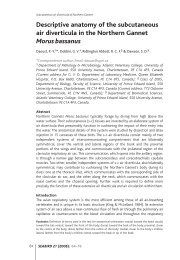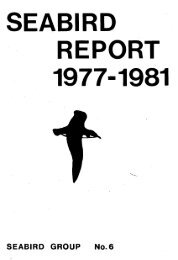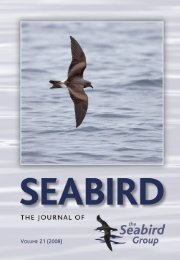You also want an ePaper? Increase the reach of your titles
YUMPU automatically turns print PDFs into web optimized ePapers that Google loves.
2001 Return rates of Common Terns 183<br />
Table 2: Test for combined effects of hatching order HO, number of fledged siblings<br />
�FS and study year SY (Logistic regression models, likelihood ratio statistic<br />
LRS (-2 log likelihood) (n = 416).<br />
Tabel 2. Test voor de gecombineerde effecten van uitkomstvolgorde (HO), het aantal<br />
uitgevlogen nestgenootjes (�FS) en het jaar van onderzoek (SY).<br />
Term Adjusted for: LRS df P value Regression coefficient SE<br />
NFS HO 570.06 1 0.723 -0.0014 0.004<br />
NFS SY 698.78 1 0.552 -0.0003 0.0013<br />
HO SY 578.59 1 0.952 0.0000 0.0001<br />
DISCUSSION<br />
In the Common Terns studied, neither hatching order nor number of fledglings<br />
per brood influenced return rates of prospecting individuals. This is in<br />
accordance with the findings of Nisbet (1996) whose study was based on a<br />
much smaller number of birds that returned. In this study we also found no<br />
evidence that potential effects of hatching order and sibling number on fledgling<br />
survival might mask each other. But why do both natal characteristics lose their<br />
importance after fledging?<br />
In the pre-fledging stage, many studies document the importance for<br />
survival of intrinsic factors such as body weight at hatching and of extrinsic<br />
factors such as hatching order or brood size (Parsons 1970; Becker & Finck<br />
1985; Rhymer 1988; Sydeman & Ems lie 1992; Nisbet et al. 1995). In several<br />
seabird species last-hatched chicks suffer higher mortality (e. g. Parsons 1970;<br />
Becker & Finck 1985; Sydeman & Emslie 1992). However, the importance of<br />
these factors for pre-fledging survival depends strongly on parental quality, as<br />
shown by studies of Bolton (1991), Nisbet et al. (1998) and Wendeln & Becker<br />
(1999). During the post-fledging stage, some studies show effects of hatching<br />
position or brood size on survival (Nisbet & Drury 1972; Coulson & Porter<br />
1985; Viksne & Janaus 1993). Other investigations, including this study, found<br />
that these factors are no longer important after fledging (Spear & Nur 1994;<br />
Nisbet 1996).<br />
In species whose young depend on being fed by the parents for a long<br />
time after fledging, as in the Common Tern (Burger 1980), parental quality is<br />
expected to be of particular importance also for post-fledging survival. At our<br />
study site, fledglings are fed by their parents up to an age of at least 64 days,<br />
that is about six weeks after fledging (Kühn & Becker, unpubl. data). Watson &<br />
Hatch’s (1999) data support the idea that parental care in the Roseate Tern<br />
Sterna dougalli may extend through the migration period as documented for the








